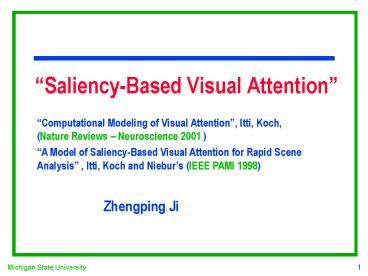- PowerPoint PPT Presentation
1 / 22
Title:
Description:
'Computational Modeling of Visual Attention', Itti, Koch, (Nature Reviews ... Saliency Map (SM) modeled as layer of leaky integrate-and-fire neurons ... – PowerPoint PPT presentation
Number of Views:60
Avg rating:3.0/5.0
Title:
1
Saliency-Based Visual Attention
Computational Modeling of Visual Attention,
Itti, Koch, (Nature Reviews Neuroscience 2001
) A Model of Saliency-Based Visual Attention for
Rapid Scene Analysis , Itti, Koch and Nieburs
(IEEE PAMI 1998)
Zhengping Ji
2
Overview
- Background
- System architecture
- The saliency map
- Preprocessing
- Feature maps
- Feature integration
- Focus of attention
- Results
- Conclusion
3
Related Work
- Feature Integration Theory, Treisman Gelade,
1980. - Computational model of bottom-up attention, Koch
and Ullman, 1985 - Saliency map is believed to be located in the
posterior parietal cortex (Gotlieb, et al., 1998)
and the pulvinar nuclei of the thalamus (Roinson
Peterson, 1992)
4
Architecture
5
Gaussian Pyramids
- Repeated low-pass filtering
- 0, 1, 2, 3,,8
- I(0) is original input
6
Preprocessing
- Original image with red, green, blue channels
- Intensity as I (r g b)/3
- Broadly tuned color channels
- R r - (g b)/2
- G g - (r b)/2
- B b - (r g)/2
- Y (r g)/2 - r g/2 - b
7
Preprocessing
Intensity
B
R
G
Y
8
Center-surround Difference
- Achieve center-surround difference through
across-scale difference - Operated denoted by Q Interpolation to finer
scale and point-to-point subtraction - One pyramid for each channel I(s), R(s), G(s),
B(s), Y(s)where s Î 0..8 is the scale
9
Intensity Feature Maps
- I(c, s) I(c) Q I(s)
- c Î 2, 3, 4
- s c d where d Î 3, 4
- So I(2, 5) I(2) Q I(5) I(2, 6)
I(2) Q I(6) I(3, 6) I(3) Q I(6)
- ? 6 Feature Maps
10
Colour Feature Maps
- Similar to double-opponent cells (Prim. V. C)
- Red-Green and Yellow-Blue
- RG(c, s) (R(c) - G(c)) Q (G(s) - R(s))
- BY(c, s) (B(c) - Y(c)) Q (Y(s) - B(s))
- Same c and s as with intensity
R-G
G-R
B-Y
Y-B
R-G
G-R
B-Y
Y-B
11
Orientation Feature Maps
- Create Gabor pyramids for q 0º, 45º, 90º,
135º - c and s again similar to intensity
12
Normalization Operator
- Promotes maps with few strong peaks
- Surpresses maps with many comparable peaks
- Normalization of map to range 0M
- Compute average m of all local maxima
- Find the global maximum M
- Multiply the map by (M m)2
13
Normalization Operator
14
Conspicuity Maps
15
Saliency Map
- Average all conspicuity maps
16
Neural Layers
Stimulus
- Saliency Map (SM) modeled as layer of leaky
integrate-and-fire neurons - SM feeds into winner-take-all (WTA) neural
network - Inhibition of Return as transient inhibition of
SM at FOA
SM
-
Inhibition of Return
WTA
FOA shifted to position of winner
17
Example of Operation
Inhibition of return
18
Results
Image Saliency Map High saliency
Locations (yellow circles)
19
Shifting Attention
- Using 2D winner-take-all neural network at
scale 4 - FOA shifts every 30-70 ms
20
Summary
- Saliecy map can be broken down into main steps
- Create pyramids for 5 channels of original image
- Determine feature maps then conspicuity maps
- Combine into saliency map (after normalizing)
- The key idea of saliency map is to extract local
spatial discontinuities in the modalities of
color, intensity and orientation. - Use two layers of neurons to model shifting
attention. - Model appears to work accurately and robustly
(but difficult to evaluate)
21
Discussion
- No top-down attention modeling, e.g., top-down
spacial control, obejct-based attention. - Biologically plausible?
- Neuromorphic architecture?
- In which way the top-down and bottom-up processes
are related? - In which way the attention and recognition are
integrated and interacted with each other?
22
References
- Itti, Koch, and Niebur A Model of
Saliency-Based Visual Attention for Rapid Scene
AnalysisIEEE PAMI Vol. 20, No. 11, November
(1998) - Itti, Koch Computational Modeling of Visual
AttentionNature Reviews Neuroscience Vol. 2
(2001)































